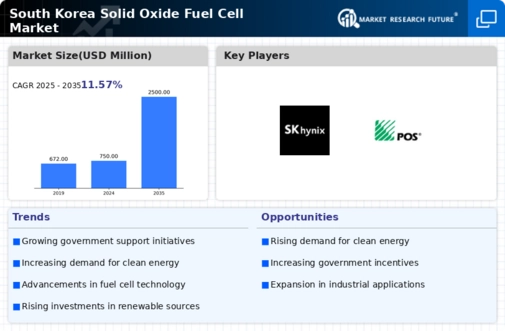Rising Energy Costs
The solid oxide-fuel-cell market in South Korea is experiencing a notable surge due to the increasing costs of traditional energy sources. As fossil fuel prices fluctuate, businesses and consumers are seeking alternative energy solutions that offer long-term savings. Solid oxide fuel cells, known for their high efficiency and low emissions, present a viable option. The market is projected to grow as more industries recognize the potential for reduced operational costs. In 2025, the energy sector in South Korea is expected to see a shift, with solid oxide fuel cells contributing to an estimated 15% of the total energy mix. This trend indicates a growing acceptance of fuel cell technology as a reliable energy source, further driving the market's expansion.
Environmental Regulations
The solid oxide-fuel-cell market is significantly influenced by stringent environmental regulations in South Korea. The government has implemented policies aimed at reducing greenhouse gas emissions and promoting cleaner energy technologies. These regulations create a favorable environment for the adoption of solid oxide fuel cells, which produce minimal pollutants compared to conventional energy sources. As industries strive to comply with these regulations, the demand for solid oxide fuel cells is likely to increase. In 2025, it is anticipated that compliance costs associated with emissions regulations will drive a 20% increase in the adoption of fuel cell technologies across various sectors, thereby enhancing the market's growth prospects.
Technological Innovations
Technological advancements play a crucial role in shaping the solid oxide-fuel-cell market in South Korea. Ongoing research and development efforts are leading to improved fuel cell designs, enhanced efficiency, and reduced production costs. Innovations such as advanced materials and manufacturing techniques are making solid oxide fuel cells more accessible and economically viable. In 2025, the market is expected to benefit from a 30% increase in efficiency due to these technological breakthroughs. This progress not only attracts investment but also encourages industries to transition towards cleaner energy solutions, thereby propelling the solid oxide-fuel-cell market forward.
Growing Industrial Applications
The solid oxide-fuel-cell market is benefiting from an expanding range of industrial applications in South Korea. Industries such as manufacturing, transportation, and power generation are increasingly recognizing the advantages of solid oxide fuel cells, including their high efficiency and low emissions. As companies seek to enhance their sustainability profiles, the adoption of fuel cell technology is likely to rise. In 2025, it is projected that industrial applications will account for approximately 40% of the total demand for solid oxide fuel cells. This trend indicates a robust market potential as various sectors leverage fuel cell technology to meet their energy needs while adhering to environmental standards.
Increased Investment in Renewable Energy
The solid oxide-fuel-cell market is poised for growth as South Korea increases its investment in renewable energy sources. The government has set ambitious targets for renewable energy adoption, aiming for 20% of the energy mix by 2030. Solid oxide fuel cells, which can efficiently convert renewable energy into electricity, are likely to play a pivotal role in achieving these targets. In 2025, the market may witness a 25% rise in demand as industries and utilities seek to integrate fuel cell technology with renewable energy systems. This alignment with national energy goals positions the solid oxide-fuel-cell market as a key player in the transition to a sustainable energy future.













Leave a Comment